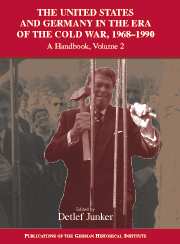Book contents
- Frontmatter
- POLITICS: Détente and Multipolarity: The Cold War and German-American Relations, 1968-1990
- SECURITY: German-American Security Relations, 1968-1990
- ECONOMICS: Cooperation, Competition, and Conflict: Economic Relations Between the United States and Germany, 1968-1990
- CULTURE: Culture as an Arena of Transatlantic Conflict
- SOCIETY: German-American Societal Relations in Three Dimensions, 1968-1990
- 1 “1968”: A Transatlantic Event and Its Consequences
- 2 Social Movements in Germany and the United States: The Peace Movement and the Environmental Movement
- 3 Women and the New Women’s Movement
- 4 Transatlantic Networks: Elites in German-American Relations
- 5 Bridging Constituencies: German Political Foundations in German-American Relations
- 6 Normalizing German-American Labor Relationships in a Changing International Environment
- 7 German and American Churches: Changes in Actors, Priorities, and Power Relations
- 8 The Twisted Road Toward Rapprochement: American Jewry and Germany Until Reunification
- 9 Difference and Convergence: Immigration Policy in the United States and the Federal Republic of Germany
- 10 Urban Planning, Transportation, and Suburban Development: Striking a Balance
- 11 Relations Between Right-Wing Extremists in Germany and the United States, 1945-1990
- 12 With America Against America: Anti-Americanism in West Germany
- 13 The Maturation of a Relationship: The Image of America in West German Public Opinion
- 14 Between Private Opinion and Official Pronouncement: Images of America in the German Democratic Republic, 1971-1990
- 15 The American Image of Germany, 1968-1991
- OUTLOOK: America, Germany, and the Atlantic Community After the Cold War
- Index
12 - With America Against America: Anti-Americanism in West Germany
Published online by Cambridge University Press: 05 January 2013
- Frontmatter
- POLITICS: Détente and Multipolarity: The Cold War and German-American Relations, 1968-1990
- SECURITY: German-American Security Relations, 1968-1990
- ECONOMICS: Cooperation, Competition, and Conflict: Economic Relations Between the United States and Germany, 1968-1990
- CULTURE: Culture as an Arena of Transatlantic Conflict
- SOCIETY: German-American Societal Relations in Three Dimensions, 1968-1990
- 1 “1968”: A Transatlantic Event and Its Consequences
- 2 Social Movements in Germany and the United States: The Peace Movement and the Environmental Movement
- 3 Women and the New Women’s Movement
- 4 Transatlantic Networks: Elites in German-American Relations
- 5 Bridging Constituencies: German Political Foundations in German-American Relations
- 6 Normalizing German-American Labor Relationships in a Changing International Environment
- 7 German and American Churches: Changes in Actors, Priorities, and Power Relations
- 8 The Twisted Road Toward Rapprochement: American Jewry and Germany Until Reunification
- 9 Difference and Convergence: Immigration Policy in the United States and the Federal Republic of Germany
- 10 Urban Planning, Transportation, and Suburban Development: Striking a Balance
- 11 Relations Between Right-Wing Extremists in Germany and the United States, 1945-1990
- 12 With America Against America: Anti-Americanism in West Germany
- 13 The Maturation of a Relationship: The Image of America in West German Public Opinion
- 14 Between Private Opinion and Official Pronouncement: Images of America in the German Democratic Republic, 1971-1990
- 15 The American Image of Germany, 1968-1991
- OUTLOOK: America, Germany, and the Atlantic Community After the Cold War
- Index
Summary
Translated by Tradukas
After World War II, as in the pre-1945 period, “America” was an arena for internal German debates on the country's political and social orientation. The West German Left, despite reservations about tying the country's foreign policy to the United States, maintained an overwhelmingly positive image of America up into the 1960s and argued for cultural and intellectual integration of Germany into the West. The right, despite its agreement with the United States on foreign policy, showed anti-American inclinations, which were directed against the cultural and social Westernization of the Federal Republic. This constellation dissolved in the course of the 1960s. The center left Social Democratic Party (Sozialdemokratische Partei Deutschlands, or SPD) came to hold a strongly pro-American position. The New Left and the student movement, by contrast, shared the radical right's reservations about the Federal Republic's social and political integration within the West. At the same time, the ideological differences between the two major parties diminished. Emerging conflicts over the environment, peace initiatives, and immigration policy in a “multicultural” society weakened the opposition between classic “left” and “right” positions. Belief in or opposition to the West” once again became an important dividing line in German politics. It was not a coincidence that “Antiamerikanismus” became a polemical term in the West German political vocabulary during the 1970s. At the same time, the increasing integration of the Federal Republic into the West meant that anti-American ideas often reflected Americans’ own criticisms of conditions in the United States and led to the formation of alliances between critics of “America” on both sides of the Atlantic. This was true for the student movement and the New Left as well as for the New Right since the 1980s.
- Type
- Chapter
- Information
- The United States and Germany in the Era of the Cold War, 1945–1990A Handbook, pp. 502 - 509Publisher: Cambridge University PressPrint publication year: 2004
- 1
- Cited by



